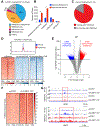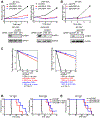N6-methyladenine DNA Modification in Glioblastoma
- PMID: 30392959
- PMCID: PMC6433469
- DOI: 10.1016/j.cell.2018.10.006
N6-methyladenine DNA Modification in Glioblastoma
Abstract
Genetic drivers of cancer can be dysregulated through epigenetic modifications of DNA. Although the critical role of DNA 5-methylcytosine (5mC) in the regulation of transcription is recognized, the functions of other non-canonical DNA modifications remain obscure. Here, we report the identification of novel N6-methyladenine (N6-mA) DNA modifications in human tissues and implicate this epigenetic mark in human disease, specifically the highly malignant brain cancer glioblastoma. Glioblastoma markedly upregulated N6-mA levels, which co-localized with heterochromatic histone modifications, predominantly H3K9me3. N6-mA levels were dynamically regulated by the DNA demethylase ALKBH1, depletion of which led to transcriptional silencing of oncogenic pathways through decreasing chromatin accessibility. Targeting the N6-mA regulator ALKBH1 in patient-derived human glioblastoma models inhibited tumor cell proliferation and extended the survival of tumor-bearing mice, supporting this novel DNA modification as a potential therapeutic target for glioblastoma. Collectively, our results uncover a novel epigenetic node in cancer through the DNA modification N6-mA.
Keywords: DNA methylation; H3K9me3; N(6)-methyladenine; brain tumor; cancer stem cell; chromatin; epigenetics; glioblastoma; heterochromatin; neuro-oncology.
Copyright © 2018 Elsevier Inc. All rights reserved.
Figures







Comment in
-
N6-mA marks the spot.Nat Rev Cancer. 2019 Jan;19(1):4-5. doi: 10.1038/s41568-018-0085-5. Nat Rev Cancer. 2019. PMID: 30451984 No abstract available.
-
N6-mA condenses chromatin.Nat Chem Biol. 2019 Jan;15(1):2. doi: 10.1038/s41589-018-0199-9. Nat Chem Biol. 2019. PMID: 30531900 No abstract available.
References
-
- Cadieux B, Ching TT, VandenBerg SR, and Costello JF (2006). Genome-wide hypomethylation in human glioblastomas associated with specific copy number alteration, methylenetetrahydrofolate reductase allele status, and increased proliferation. Cancer research 66, 8469–8476. - PubMed
Publication types
MeSH terms
Substances
Grants and funding
- R01 CA171652/CA/NCI NIH HHS/United States
- R35 CA197718/CA/NCI NIH HHS/United States
- R01 NS089272/NS/NINDS NIH HHS/United States
- F30 CA217066/CA/NCI NIH HHS/United States
- R01 NS087913/NS/NINDS NIH HHS/United States
- F30 CA217065/CA/NCI NIH HHS/United States
- R01 CA184090/CA/NCI NIH HHS/United States
- R01 DK078803/DK/NIDDK NIH HHS/United States
- R01 DK068471/DK/NIDDK NIH HHS/United States
- R01 NS099175/NS/NINDS NIH HHS/United States
- R01 NS091080/NS/NINDS NIH HHS/United States
- F30 CA203101/CA/NCI NIH HHS/United States
- R01 CA169117/CA/NCI NIH HHS/United States
- R01 GM114205/GM/NIGMS NIH HHS/United States
- R01 CA154130/CA/NCI NIH HHS/United States
- R01 NS103434/NS/NINDS NIH HHS/United States
- DP3 DK112155/DK/NIDDK NIH HHS/United States
- T32 GM007250/GM/NIGMS NIH HHS/United States
- UC4 DK104202/DK/NIDDK NIH HHS/United States
- R01 CA187780/CA/NCI NIH HHS/United States
LinkOut - more resources
Full Text Sources
Other Literature Sources
Medical
Molecular Biology Databases
Research Materials

